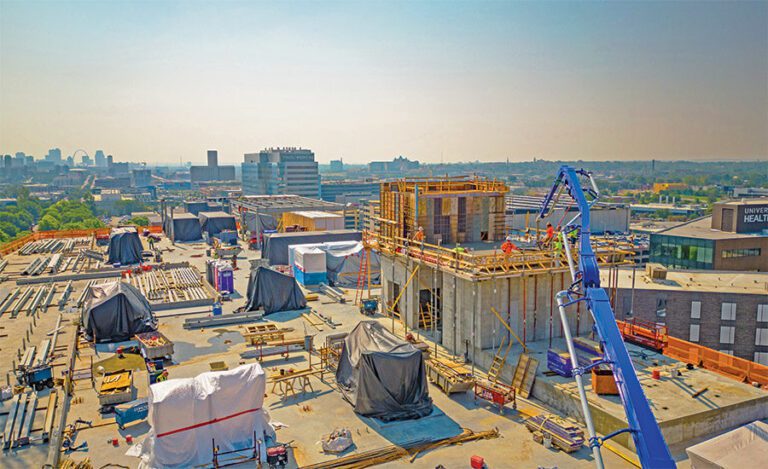As many workers and companies continue to adopt hybrid and remote models established during the COVID-19 pandemic—even several years after its onset—the impact on construction continues, with some sectors thriving and others declining. Despite the changing landscape, contractors continued to see good performance overall in the 11-state Midwest region.
Of the 80 companies included in ENR Midwest's 2023 Top Contractors rankings, the top 25 companies reported combined revenue of $40.64 billion in 2022, showing steady growth compared to the $35.59 billion reported by the top 25 companies in past period.
“It's a tale of two economies,” observes Bob Clark, executive chairman and founder of Clayco. “Commercial urban development will hit the rocks. The office will be mostly toxic due to incredibly high vacancies and higher interest rates in the near term.”
But he notes that contractors who can travel and perform design-build work are thriving and will be flooded with opportunities in advanced manufacturing, food and beverage, industrial projects, green energy projects and cloud-scale data centers.
Across the Midwest, Clayco has seen a big uptick in contracts and pipelines in its aerospace, industrial, institutional and manufacturing businesses, Clark says. “Legislation, including the CHIPS Act and the Lower Inflation Act and the demand for aid stemming from the supply chain constraints of the COVID era, helped in 2022 and set the table for 2023,” he says. “This momentum continued this year and was further extended by the rise in AI adoption and increased manufacturing speed.”
Some markets will remain strong because they are more substantial and less affected by economic forces, notes John Buescher, president of McCarthy Building Cos.'s Central region. “These include water and wastewater treatment facilities, renewable/solar energy, healthcare, educational institutional facilities and industrial process and manufacturing facilities,” he says.
There are also more projects funded by the government and/or supported through programs like the American Rescue Plan Act, Infrastructure Investment and Jobs Act and other programs that fund both the public and private sectors, Buescher adds. “We will monitor interest rates in the long term. As inflation has slowed recently, there is hope that interest rates will begin to decline over the next 12 to 24 months.”
Navigating the waters
“Regardless of various economic indicators, business is strong across the Midwest and the country,” says Chuck Binkowski, COO of Barton Malow Holdings. “There will always be challenges and the potential for disruption, which will continue to evolve as the pace of change accelerates. The pace of change has never been so fast, but it will never be so slow again.”
Barton Malow's commercial and institutional division sees professional and club sport as its most important growth market. Another growing area is healthcare.
As for its industrial and union division, “the growth in EV battery manufacturing facilities has been exponential,” says Binkowsi. “This has driven much of our revenue growth in the Midwest and across the country. Projects like Ultium Cells and BlueOval SK aim to electrify the future of mobility.”
For Clune Construction Co., diversification has helped maintain its backlog, says Vince Gutekanst, president, Midwest region. “Chicago is probably our main market for interior tenant space, and that's still lagging as people go back to work,” he says. “Occupancies are way down and the hybrid work environment is impacting deal completion in the city.”
Better pre-planning has mostly mitigated the market volatility and long lead times seen over the past year, Gutekanst says. “But in 2023, Chicago was — knock on wood — pretty solid for us across all of our major markets,” he says.
Thanks to a strong workforce with the ability to do more technical work, Clune has been able to shift resources to assist and even perform some larger critical tasks. “We've been lucky to have good diversification. We have picked up some work at some of the airports here and that vertical will continue to improve,” says Gutekanst. “Healthcare is still a little behind for us, but there are opportunities.”
Meanwhile, Miron Construction Co. continues to see strength in its core markets, including food, energy, healthcare and education, says Tim Kippenhan, vice president and COO. “Owners seem to be more cautious in their capital spending,” he says. “The continued escalation of construction costs gives us concern that more projects will be slowed or put on hold next year.”
Business in the Chicagoland area continues to be solid for McShane Construction Co. Although 2023 is tracking similarly to 2022 in business and revenue, new business signings have slowed somewhat as capital markets determine how to account for rising interest rates and banking stress, says Mathew Dougherty, company President.
Business is solid in the core multifamily and industrial markets across the region, but “the biggest challenge we're facing right now is the impact capital markets have on the flow of transactions going forward,” he says. “We are seeing new projects slow to close as capital has become tighter. We remain bullish given the high demand and strong market fundamentals across both multifamily and industrial property types.”
Eyes Ahead
Industry leaders agree that inflation and interest rates will continue to be an issue for construction going forward. But one of the Midwest's strengths is its resilience despite economic uncertainty.
Heading into late 2023 and beyond, “It's going to be a strong case of the haves and the have-nots,” notes Clark. “Office, residential and commercial will be tough and institutional, infrastructure, advanced manufacturing and industrial will continue to do well. The Biden White House's initiatives in infrastructure, advanced manufacturing, chipmaking, and green energy will change the face of the economy along with boosting activity — if we also get our work cut out for labor shortage and immigration laws.” .

